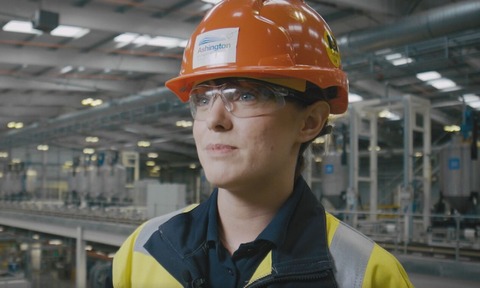Scaling up efficiency and sustainability with AkzoNobel
18 Feb 2020

Siemens has helped ensure the entire manufacturing process at paint giant AkzoNobel’s state-of-the-art factory in Ashington, is digitalised, yielding phenomenal speed and efficiency gains.
Like every modern process company AkzoNobel must negotiate an array of potentially conflicting demands – producing more, better and faster while achieving stringent regulatory compliance and meeting its ambitious sustainability goals.
Add to that the need to ensure that the technological and software solutions it adopts are scalable for a massive global operation.
Head of the manufacturing unit at AkzoNobel Ashington Jeff Hope explained:
“We wanted to utilise the automation technology to meet the ever-increasing production needs of our customers, continue to meet the safety regulations in the chemical and manufacturing industries, but also to achieve our own sustainability goals of reducing waste, reusing energy and using less solvent.
Thanks to what it claims is a ground-breaking collaboration with Siemens, it has created a state-of-the-art £100m factory in Ashington, which connects the entire manufacturing process horizontally and vertically, allowing for the end-to-end digitalisation of the plant.
This integrated solution combines Siemens’ SIMATIC PCS 7 control system, incorporating hundreds of Siemens Automation Systems, BATCH control and two SIMATIC IT Manufacturing Execution Systems (MES) with AkzoNobel’s enterprise business system.
The business system from SAP (Systems, Applications and Products) manages operations such as delivery, logistics and customer relations.
Batch targets already being met are on a scale that had never been achieved before
Every activity, from the ordering of raw materials to the shipping of finished products, can be initiated without human intervention.
AkzoNobel believes the investment has enabled the business to make a step-change on a scale not seen before, propelling it forward by 30 years, says Hope.
“In the chemical industry, processes are typically fixed and have been for years, there’s not a lot of innovation, so we were doing something entirely different here.”
Over the last two years the factory has been ramping up its production capacity and can now manufacture 1M litres of paint per week. producing up to 33,000 different colours across a range of brands.
These improvements have reduced the time to market by 85%, from three months to just two weeks.
The plant also aims to reuse 100% of its water and 90% of solvents back into the process once the materials have been treated in the onsite by-products plant.
Meanwhile, a biomass boiler and solar panels onsite produce 10% of the energy needed to power the plant, and any rainwater harvested is also used in the production process. AkzoNobel estimates that the carbon footprint per litre of paint produced at Ashington has reduced by 50.
Alex Wardle (phot0), process engineer at AkzoNobel Ashington, outlined the logistical improvements:
“The site is so agile that we can only hold three days’ stock at any one time. We make 3,500 different products from this site, and traditionally that could have taken up to three months to do; but here the levels of automation mean that we are able to turn that production wheel in only two weeks.”
The next target for plant is to increase capacity by 50% to 1.5 million litres per week.
Mark Higham, general manager of process automation at Siemens, said: “The automation allows AkzoNobel to be really agile. They need to be able to respond quickly, dependent on seasonal demand – our solution makes this possible
“We can accommodate not only these large plants, but also cost-effectively address the small-scale ones as well. We also have a range of tools that will help us easily migrate legacy control systems into the Siemens SIMATIC PCS 7 platform, thus enabling existing plants to be efficiently modernised.”

